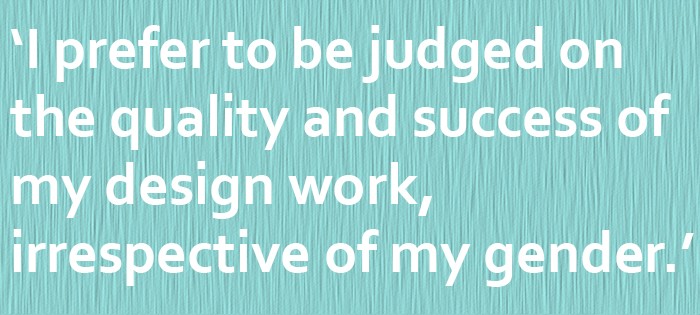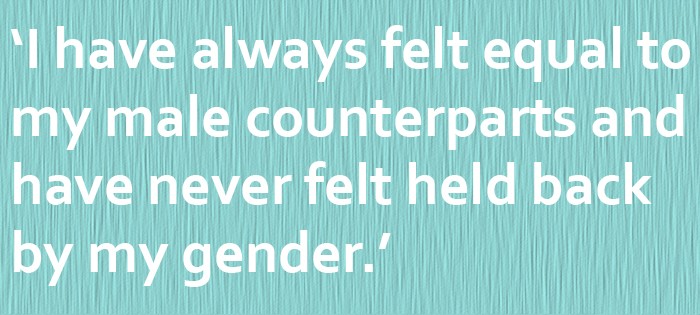Female Furniture Designers?
I recently realised that perhaps part of my experience as a furniture designer has not been the industry standard.
I worked for many years for Katerina McMahon, the inspiring Design Director at Morgan, within a design team of at least 50% female designers. In May the Furniture Makers Company presented their 2016 Design Guild Mark Awards, which promote excellence and raise the profile of British design and innovation. In 2016 a total of 19 Guild Marks were awarded but whilst creating a recent Design Insider post, which looked at the winners comments, I realised that only 3 of the 19 awards were awarded to women. This statistic prompted me to question if my experience reflected the industry norm and I decided to seek comment from industry leaders on the place of women as UK furniture designers.
I have been fascinated by the varied responses I received:
Emily Martin, Assistant editor FX
‘While we do celebrate many more female designers in industry (thankfully), the female to male designer ratio is still very much weighted to the male side. Even so as more female graduates leave university with design degrees and entering the profession, it would appear that women’s role in design still largely remains with the so–called soft positions of the workforce. It’s typical to see women fill industry roles including marketing, public relations, studio manager, personal assistants, design assistants, and events management. So the question is: why are fewer women not succeeding, if not for a better word, as design innovators? Until then we will continue to see more men win design awards.’
Mirka Grohn, AndNew (Design Guild Mark 2016 Winner)
‘It is probably true to say men still dominate the furniture design field in Britain. In the past year we received two major design awards, which surprised us, as these kinds of awards more often go to men. We have also found that the manufacturing is very male orientated as virtually every single maker is a man and the factories are run by men, too. Therefore we have encountered some selective hearing and challenges when pushing through experimental prototypes and ideas. Luckily we have thick skins and we just keep on going.’
Katerina McMahon BA MA RCA, Design Director Morgan
‘We have a good proportion of women in our design and senior management teams, all of whom have been appointed on merit. This is a topic that surprises me and could potentially diminish women. I don’t agree that there are special difficulties if you are a woman in design – not as long as you are professional and committed to your work. Personally, I prefer to be judged on the quality and success of my design work, irrespective of my gender.
It may be that men are perceived as having more success because they may be more enthusiastic self promoters, however, there are many highly successful designers of both genders who pursue their profession without wishing to be in the limelight.’
Rachel Galbraith, Creative Director Ercol
‘My experience working within the furniture industry over the last 20 years, has seen a vast change in the way we view furniture as a consumer, driving in its wake a sizeable rise of women working within key areas of the trade. Throughout my career I have worked alongside many women working as designers, design managers, heads of design and design directors that influence and lead the industry from a wider global vision. I would agree that the British furniture industry has been historically male dominated and that areas such as bespoke, handcrafted and the technical design environment are still very much within the male remit. However the change in consumer demand and expectation which has been led primarily through technology and fashion with the dominance of online and high street brands, shaping our lifestyle, habits and desires, creates the designer and creative of today as fast paced, omnipresent and globally astute. You will find many a female furniture designer and creative leading within this commercial arena.’
Ben Burbidge, Master of The Furniture Makers’ Company
‘The Furniture Makers’ Company, the furnishing industry’s charity, is equally devoted to encouraging both women and men to pursue a career in the furnishing sector. One of the ways in which we do this is through our many education initiatives where we support students and young people with grants, training and mentoring in order to foster talent and safeguard the future of the industry.
While livery companies may have traditionally been male dominated, The Furniture Makers’ Company is positively embracing diversity. We have six females on our court and in three years’ time we will have our second lady Master.’
Lucy Kurrein, Designer
‘Whilst it’s true that almost all the furniture companies I have worked with have men at the helm, I have always felt equal to my male counterparts and have never felt held back by my gender. In my experience work forces in the industry are becoming increasingly more balanced, and the furniture and product design course I teach on at Kingston University actually has more women than men on it. It could be a matter of time before we strike more of a gender balance in the public eye too.’
Francesca Rossi, Designer
‘Many industries are historically male dominated, and furniture design is no exception. The industry is working towards gender-balance, but it has to be said, it is difficult to be taken seriously. As a 25 year old woman, on more than one occasion I have come across condescending questions regarding my role, especially when presenting work, in meetings and contacting material suppliers. There is considerable progress to be made, especially within the education sector, to not be pigeon-holed as a male’s assistant. It seems that women in this industry can expect to hit many barriers, but whilst we continue to work against the odds, we are working towards breaking the stereotypes.’
I welcome you to join this discussion using the comment options below or on our social media platforms including twitter here.







Comments
Thanks for this Alys – very interesting! What your examples show is that the landscape with regard to gender discrimination is varied, so it would be interesting to gather some statistical evidence. For example, since starting to help furniture course graduates find work in the furniture industry, of all the people I have helped place in furniture industry jobs, only 1 in 10 are male, yet in the group of final year furniture design & make students I currently teach, only two are female in the group size of 18. There is clearly a mismatch.
The reasons could be manifold:
Career choice – girls at school are generally not presented with furniture design as an option in most schools. Textile design, graphic design, fine art, ceramics and fashion…are more often part of the art & design ‘diet’ at school, and anyone wanting to study Architecture at degree level is treated in even higher academic esteem by many teachers (I was encouraged to study architecture by my teachers rather than furniture design, which was never mentioned). By comparison, furniture design is invisible, and girls, like me, only stumble across it by chance, either because a teacher (in my case, a Foundation Course tutor) brings it to their attention, or they hear about it from a friend or family member. Changes to the national curriculum (and for example the current EBACC debates) which talk about the reduction and even removal of creative subjects as core subjects only adds to the lack of visibility and importance of the subject at school level.
Male dominant subject (in University and other HE courses):
When I studied furniture design at uni in the 1980s, I was the only female on both my BA and MA courses. Today, figures have improved, but not to the extent where there is yet equal gender balance on furniture courses (and with less furniture specific courses, there will also be less furniture skilled people anyway – male and female).
TV/media presence of the subject:
Unlike baking and cooking (The Great British Bake-off; Masterchef), sewing (The Great British Sewing Bee), furniture design doesn’t get the airtime. Gok Wan’s Fill Your House For Free, new to Channel 4, is perhaps an exception and Grand Designs rarely tackles the design of the furniture, frustratingly featuring Eames and Corbusier chair lookalikes on the CAD visuals on almost every programme.
Reasons for drop in self-esteem/confidence:
For me, this is perhaps the most worrying – I find many female graduates, often with first class degrees and MAs, working in retail shops, cafes and other non-design related, low paid work. They tell me that if they don’t find a job in the industry on leaving college, they have to work, because of their debt from Uni/college fees, just to pay the rent and bills. The longer they do this work, the harder it is to break the cycle and find a job in the industry because they work such long hours. They lose confidence and become dependent on the job they don’t necessarily like. They find it hard to get help to write a CV and prepare a portfolio, and if they have other commitments like children typically, it is even more difficult. Male graduates can of course experience similar situations, but I have found these to be less problematic.
The good news is that I have discovered employers who are sympathetic to helping these graduates get back into the furniture industry roles, and are now offering support (by offering to pay for graduates to learn language or CAD skills for example) and training for people with the attitude and potential they are looking for.
We still need to inspire young women to both enter and then to remain, in the industry. There will always be the people who don’t need help, who through hard work, talent (and some amount of luck often) have no experience of gender discrimination throughout their careers which is always great to hear about. It is my personal belief however, that there are a great many more, particularly leaving university courses these days, who do.
Really enjoyed reading this article and as a British female furniture designer and maker, I can definately agree that it’s a lot tougher for women to keep pushing through any unconscious bias and bounderies that present themselves within this predominately male dominated field, however extremely rewarding when you recognise your own significance, personal journey and are acknowledged for your unique offering to the field of furniture design and craftsmanship. Thank you for posting this.